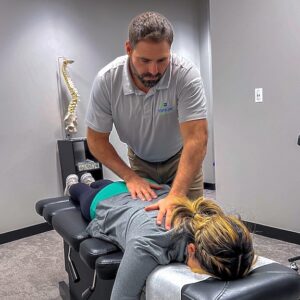Navigating through the treacherous waters of back pain can feel like trying to navigate through a dense forest with no compass. You’re left wondering which path to take, unsure of when to seek the guidance of a chiropractor.
But fear not, for in this discussion, we will shed light on the signs that indicate the right time to seek chiropractic intervention.
So, strap on your boots and prepare to embark on a journey of discovery, as we uncover the clues that will lead you to the relief you seek.
Understanding the Causes of Back Pain
Understanding the causes of back pain is crucial to effectively address and alleviate this common condition. When it comes to chiropractic care, knowledge of these causes is essential for a targeted and personalized approach to treatment. Chiropractors, also known as chiros, focus on the relationship between the spine and the nervous system, aiming to restore and maintain overall health and wellness.
Back pain can have various causes, including poor posture, muscle strain, and spinal misalignment. Chiropractors are trained to identify these underlying issues and provide appropriate interventions. Poor posture, such as slouching or hunching over a desk, can put excessive stress on the spine, leading to discomfort and pain. Muscle strain, often caused by lifting heavy objects or sudden movements, can also result in back pain. Chiropractic adjustments can help realign the spine and alleviate muscle tension, providing relief and promoting healing.
Spinal misalignment, or subluxation, occurs when the vertebrae in the spine aren’t properly aligned. This can occur due to injury, poor posture, or repetitive motions. Chiropractors use gentle and precise adjustments to correct these misalignments, relieving pressure on the nerves and reducing pain. By addressing the root causes of back pain, chiropractic care promotes holistic health and wellness.
Recognizing Persistent or Severe Pain
If you’re experiencing persistent or severe pain in your back, it’s crucial to seek immediate medical attention. Ignoring or downplaying the severity of your pain can lead to further complications and delayed treatment.
Persistent pain refers to pain that lasts for an extended period, typically for more than three months. This type of pain may indicate an underlying condition that requires medical intervention.
Severe pain, on the other hand, is intense and unbearable, often affecting your ability to perform daily activities. It can be a sign of a serious problem such as a herniated disc, spinal stenosis, or a spinal fracture.
Seeking chiropractic intervention for persistent or severe back pain is essential because chiropractors are trained to diagnose and treat musculoskeletal conditions that may be causing your pain. They can provide non-invasive treatments such as spinal adjustments, stretches, and exercises that can help alleviate your symptoms and improve your overall spinal health.
Identifying Limited Range of Motion
To identify a limited range of motion, pay attention to any difficulties or restrictions you experience when moving your back. Range of motion refers to the extent to which you can move your back in different directions without any discomfort or pain. It’s important to note that everyone’s range of motion may vary due to factors such as age, physical fitness, and previous injuries. However, if you notice a significant decrease in your ability to move your back or if you experience pain or stiffness when performing certain movements, it could be an indication of a limited range of motion.
One way to identify a limited range of motion is by performing simple stretching exercises that target the muscles and joints in your back. For example, try bending forward to touch your toes or twisting your torso from side to side. Pay attention to any pain, stiffness, or resistance you may encounter during these movements.
Another way to assess your range of motion is by comparing it to what’s considered normal for your age and level of fitness. If you find that you’re unable to move your back as freely as you used to or as freely as others, it may be a sign that you have limited range of motion.
Noticing Tingling or Numbness in the Back
After identifying a limited range of motion in your back, the next important aspect to observe is any tingling or numbness that you may experience in this area. Tingling or numbness in the back can be indicative of nerve irritation or compression, which may require chiropractic intervention.
Tingling or numbness can occur for various reasons, including spinal misalignment, muscle imbalances, or herniated discs. When the spine is misaligned, it can put pressure on the nerves, leading to a tingling or numb sensation. Muscle imbalances can also cause tension in the back, leading to nerve compression and similar symptoms. Additionally, a herniated disc can irritate nearby nerves, resulting in tingling or numbness.
If you notice tingling or numbness in your back, it’s essential to seek chiropractic intervention promptly. Chiropractors are trained to assess spinal alignment and identify any underlying issues that may be causing these symptoms. Through gentle adjustments and other non-invasive techniques, chiropractors can help relieve nerve compression and restore proper function to the spine.
Experiencing Pain That Radiates to Other Areas
Experiencing pain that radiates to other areas can be a sign of underlying issues in your back. When you feel pain that starts in your back and then spreads to different parts of your body, it could indicate a more serious condition. This type of pain, known as radicular pain, is often caused by compressed nerves or herniated discs in your spine.
If you have pain that radiates down your leg, it may be a result of sciatica. This condition occurs when the sciatic nerve, which runs from your lower back to your feet, becomes irritated or compressed. The pain can be sharp, shooting, or aching, and it may be accompanied by numbness, tingling, or weakness in your leg or foot.
Another condition that can cause radiating pain is spinal stenosis. This occurs when the spaces within your spine narrow, putting pressure on the nerves. The pain can radiate to your buttocks, hips, or legs, and it may worsen with certain activities like walking or standing.
If you experience pain that spreads to other areas of your body, it’s important to seek chiropractic intervention. A chiropractor can assess your condition, identify the underlying cause, and provide appropriate treatment to alleviate your pain and improve your overall spinal health.
Don’t ignore the signs; take action to find relief and prevent further complications.
Discovering Muscle Weakness or Imbalance
Are you noticing any signs of muscle weakness or imbalance in your body? If so, it may be time to consider seeking chiropractic intervention for your back pain. Muscle weakness or imbalance can contribute to the development or exacerbation of back pain. It can affect your posture, stability, and overall function, leading to discomfort and reduced quality of life.
Muscle weakness refers to a decrease in muscle strength, making it difficult to perform tasks that require physical exertion. Imbalance, on the other hand, means that there’s an uneven distribution of strength or tension between different muscle groups. This can result in abnormal movement patterns and increased stress on certain areas of the body, including the back.
When you experience muscle weakness or imbalance, it’s important to address the underlying causes and restore proper function. Chiropractic care can help by identifying and correcting any misalignments or dysfunctions in the spine and musculoskeletal system. Through manual adjustments, exercises, and other therapeutic techniques, chiropractors can improve muscle strength, restore balance, and alleviate back pain.
If you’re experiencing muscle weakness or imbalance, don’t wait for it to worsen or lead to more serious problems. Consult with a chiropractor who can assess your condition and develop a personalized treatment plan to address your specific needs. By addressing these issues promptly, you can prevent further complications and improve your overall well-being.
Realizing the Impact of Posture on Back Pain
Improving your posture can have a significant impact on reducing back pain. When you maintain proper posture, you help to distribute the weight of your body evenly, relieving unnecessary stress on your back muscles and joints. Slouching or hunching over can strain the muscles in your back, leading to discomfort and pain. By maintaining good posture, you can alleviate this strain and decrease the risk of developing chronic back pain.
One important aspect of good posture is aligning your spine properly. When your spine is aligned, it allows for optimal functioning of the muscles and nerves in your back. This alignment reduces the likelihood of experiencing pain caused by pinched nerves or muscle imbalances. Additionally, maintaining good posture helps to improve the flexibility and strength of your back muscles, further reducing the risk of injury and discomfort.
To improve your posture, start by being mindful of your body positioning throughout the day. Sit and stand with your back straight and shoulders relaxed. Avoid slouching or crossing your legs while sitting. Engaging in regular exercise, such as stretching and strengthening exercises, can also help to improve your posture and reduce back pain.
Considering Previous Injuries or Trauma
Considering any previous injuries or trauma is essential for understanding the impact they may have on your back pain and overall posture. Whether you have experienced a sports-related injury, a car accident, or a fall, these incidents can potentially cause long-term effects on your back. A chiropractor can help assess and address any underlying issues resulting from past injuries or trauma.
Injuries such as fractures, sprains, or strains can disrupt the natural alignment of your spine, leading to chronic pain and poor posture. Even if you have received medical treatment for your previous injuries, there may still be residual effects that can contribute to your current back pain. By seeking chiropractic intervention, you can receive a thorough evaluation of your spine and determine if any misalignments or imbalances are present.
Furthermore, trauma to the back can cause muscle imbalances and tightness, which can affect your posture and overall spinal health. These imbalances can lead to compensatory movements and strain on other areas of your back, exacerbating your pain. A chiropractor can provide targeted adjustments and therapeutic exercises to alleviate these imbalances and improve your posture.
Assessing the Effectiveness of Other Treatments
You can evaluate the effectiveness of other treatments for your back pain by consulting with a chiropractor. While there are numerous treatment options available, it can be challenging to determine which ones will provide the most relief. By seeking the advice of a chiropractor, you can gain valuable insights into the effectiveness of these treatments.
Chiropractors are highly trained professionals who specialize in the musculoskeletal system, including the spine. They have extensive knowledge of different treatment modalities and can offer expert opinions on their effectiveness. Whether you have tried medications, physical therapy, or alternative therapies, a chiropractor can assess the outcomes and provide guidance based on their expertise.
During your consultation, the chiropractor will review your medical history, perform a physical examination, and may request diagnostic tests if necessary. This comprehensive evaluation will help them understand your specific condition and the treatments you have previously undergone. They can then offer recommendations on which treatments may be most effective for your back pain.
Additionally, chiropractors may provide alternative treatment options that you may not have considered before. These may include spinal adjustments, therapeutic exercises, or lifestyle modifications. By exploring these options, you can expand your treatment choices and potentially find a solution that brings significant relief.
Trusting Your Instincts and Seeking Professional Help
After consulting with a chiropractor to assess the effectiveness of other treatments for your back pain, the next step is to trust your instincts and seek professional help. Chiropractic care can provide relief for various types of back pain, but it’s crucial to listen to your body and recognize when it’s time to seek further assistance. If you find that your pain is worsening or not improving after trying different treatments, it may be an indication that you need additional help.
Trusting your instincts is important because you know your body better than anyone else. If you feel that something isn’t right or that your pain isn’t being adequately addressed, it’s essential to seek the expertise of a professional. They can evaluate your condition and provide a more comprehensive treatment plan tailored to your specific needs.
Remember, seeking professional help doesn’t mean that you’re giving up or admitting defeat. It shows strength and determination to take control of your health and well-being. By seeking assistance from a chiropractor or other healthcare professional, you’re taking proactive steps toward finding a solution for your back pain.
In addition to trusting your instincts, it’s important to choose a chiropractor or healthcare provider who’s knowledgeable and experienced in treating back pain. Look for someone who has a good reputation and positive reviews from other patients. Don’t be afraid to ask questions and discuss your concerns openly. A good healthcare provider will listen to you, address your concerns, and work with you to develop an effective treatment plan.
If you’re experiencing persistent or severe back pain, limited range of motion, tingling or numbness, pain that radiates to other areas, or have had previous injuries or trauma, it may be time to seek Palatine chiropractic intervention.
Additionally, if other treatments haven’t been effective or if your instincts are telling you to seek professional help, it’s important to trust those instincts.
Chiropractic care can provide relief and help address the underlying causes of your back pain.
Why Choose Us?
Step into a realm of optimal well-being at Evolve Chiropractic, conveniently nestled within the Buehler YMCA in Palatine. Our dedicated team of chiropractors is committed to providing personalized care, utilizing cutting-edge techniques to enhance your overall health.
At Evolve Chiropractic, we understand that each individual is unique, and so are their wellness needs. Our comprehensive chiropractic services are tailored to address specific concerns, whether you seek relief from chronic pain, aim to improve flexibility, or simply wish to enhance your overall vitality.
Evolve Chiropractic (Inside Buehler YMCA)
1400 W Northwest Hwy, Palatine, IL 60067
(847) 496-4567
https:///locations/chiropractor-in-palatine-il-ymca/





